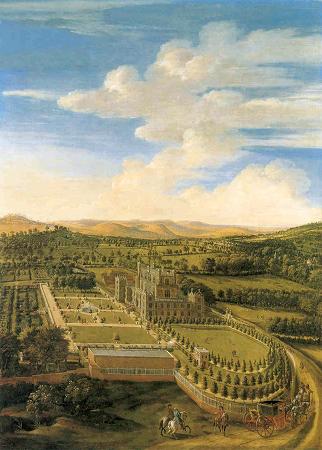
Wollaton Hall and Park, Nottinghamshire. Wollaton Hall is a country house standing on a small but prominent hill in Wollaton Park, Nottingham, England.
The house is now Nottingham Natural History Museum, with Nottingham Industrial Museum in the out-buildings. The surrounding park land is regularly used for large-scale outdoor events such as rock concerts, sporting events and festivals.
Wollaton Hall was built between 1580 and 1588 for Sir Francis Willoughby and is believed to be designed by the Elizabethan architect, Robert Smythson, who was the architect of Hardwick Hall. The style is Elizabethan with early Jacobean elements.
The floor plan has been said to derive from Serlio's drawing of Giuliano da Majano's Villa Poggio Reale near Naples of the late fifteenth century, with elevations derived from Hans Vredeman de Vries. The architectural historian Mark Girouard has suggested that the design is in fact derived from Nikolaus de Lyra's reconstruction, and Josephus's description, of Solomon's Temple in Jerusalem, with a more direct inspiration being the mid-sixteenth century Mount Edgcumbe in Cornwall, which Smythson knew.
The building is of Ancaster stone from Lincolnshire, and is said to have been paid for with coal from the Wollaton pits owned by Willoughby. Cassandra Willoughby, Duchess of Chandos recorded in 1702 that the master masons, and some of the statuary, were brought from Italy. The decorative but ludicrou
The house is now Nottingham Natural History Museum, with Nottingham Industrial Museum in the out-buildings. The surrounding park land is regularly used for large-scale outdoor events such as rock concerts, sporting events and festivals.
Wollaton Hall was built between 1580 and 1588 for Sir Francis Willoughby and is believed to be designed by the Elizabethan architect, Robert Smythson, who was the architect of Hardwick Hall. The style is Elizabethan with early Jacobean elements.
The floor plan has been said to derive from Serlio's drawing of Giuliano da Majano's Villa Poggio Reale near Naples of the late fifteenth century, with elevations derived from Hans Vredeman de Vries. The architectural historian Mark Girouard has suggested that the design is in fact derived from Nikolaus de Lyra's reconstruction, and Josephus's description, of Solomon's Temple in Jerusalem, with a more direct inspiration being the mid-sixteenth century Mount Edgcumbe in Cornwall, which Smythson knew.
The building is of Ancaster stone from Lincolnshire, and is said to have been paid for with coal from the Wollaton pits owned by Willoughby. Cassandra Willoughby, Duchess of Chandos recorded in 1702 that the master masons, and some of the statuary, were brought from Italy. The decorative but ludicrou
Wikipedia ...